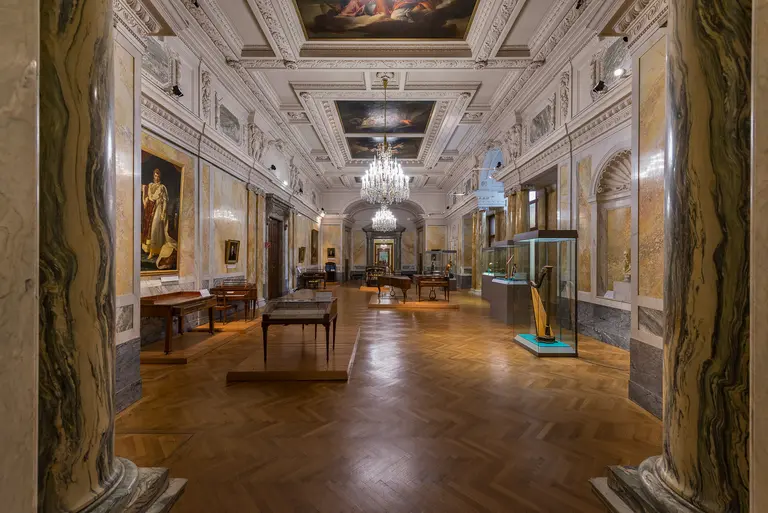Address
Collection of Historic Musical Instruments
Heldenplatz, 1010 Vienna
Google Maps
Tickets
Adult 16€
Reduced admission 12€
Kids / Teens under 19 free

The Collection of Historic Musical Instruments offers a captivating journey through European music history in the heart of the music city of Vienna. It stores, maintains, and presents numerous instruments played by famous musicians and composers. The valuable inventory of instruments brings to life the soundscape of the Renaissance, the composer-emperors of the Viennese Baroque era, and proponents of Viennese Classicism such as Haydn, Mozart, and Beethoven, in addition to the Romantic and subsequent eras.
In the private chambers once built for the royal couple Elisabeth and Franz Joseph I, a musical treasure trove unfolds: distinctive 16th century instruments, illustrious pieces owned by the imperial household, and pianos that once filled the air with music at the hands of virtuosos like Wolfgang Amadeus Mozart, Clara Schumann, Johannes Brahms, and Franz Liszt. The most special exhibits include four stringed instruments by Jacob Stainer bestowed upon the collection by Dr Herbert and Evelyn Axelrod.
Address
Collection of Historic Musical Instruments
Heldenplatz, 1010 Vienna
Google Maps
Tickets
Adult 16€
Reduced admission 12€
Kids / Teens under 19 free
An instrument museum of the highest calibre
With its cornucopia of rarities and unique pieces, the new instrument department at the Kunsthistorisches Museum is unrivalled.
this priceless collection
The Collection of Historic Musical Instruments presents masterful works of instrument construction. The exhibits range from early masterpieces of 16th century instrumental music to the rediscovery of early music in the 20th century. Each piece reflects both the musical and technological innovations of its era. Explore the different musical eras with our multilingual audio guide that explains the exhibits’ technological features and the craftsmanship behind them. The guide invites visitors to sample a treasure trove of musical excerpts and discover the unique sounds made by the instruments they see.
During the concerts in the Collection of Historic Musical Instruments, visitors have the unique opportunity not only to admire the displayed instruments but also to experience their sound—provided the instruments' preservation status permits it.
The Collection of Historic Musical Instruments can look back on a tradition that spans more than four centuries. In the second half of the 16th century, Archduke Ferdinand II established one of the late Renaissance’s most opulent and valuable Chambers of Art and Wonders at Ambras Castle. An important component was an exquisite collection of musical instruments. More than 80 instruments – mostly elaborately crafted pieces dedicated to the music and art-loving Tyrolean ruler – survive to this day.
The second core of the Collection of Historic Musical Instruments consists of objects from the Italian late Renaissance and early Baroque periods that hark back to the music-loving collectors of the Obizzi family who lived in Catajo Castle. A collection of musical instruments first mentioned in Descrizione del Catajo by Giuseppe Betussi in 1669 was expanded considerably by Marchese Tommaso Gravato degli Obizzi (1750–1803). Archduke Franz Ferdinand eventually inherited Catajo, whereupon the collection was sent to Vienna and, in 1914, was assimilated into the imperial collection. As a result of these two long-standing collections, the Kunsthistorisches Museum now houses a collection of Renaissance and baroque instruments of global uniqueness.
The first collective exhibition of the musical instruments in two rooms of the Neue Burg took place in 1916, followed four years later by the first catalogue. An administratively independent collection was created in 1939 when part of this new collection – which by then contained over 400 instruments, together with loans from the Gesellschaft der Musikfreunde (Society of Friends of Music) – went on display at the Palais Pallavicini. In tandem with this, the first in-house concerts – billed as ‘Hausmusiken’ – took place, featuring music played on some of the items in the collection.
Following the period of National Socialism, the exhibition was once more relocated to the Neue Burg and remained a key attraction for the pioneers of the rediscovery of early music. Isolde Ahlgrimm, Alice and Nikolaus Harnoncourt, Josef Mertin, Gustav Leonhardt, Karl Scheit, and many others have been associated with the collection over the years. Since the reorganisation in 1993, the instruments have been displayed across 12 rooms. The restoration workshop has been training students in musical instrument restoration since 1997 as part of a collaboration with the Academy of Fine Arts. Numerous publications, catalogues, technical drawings of the instruments, CD recordings, and concerts appeal to a diverse audience and offer comprehensive access to the collection.
Find out more about the scientific work of the Collection of Historic Musical Instruments.
Our exhibitions take you back to the rich history of our museum. Here, proven masterpieces meet newly explored themes - a look at art, culture and the past that continuously illuminates the collection.

